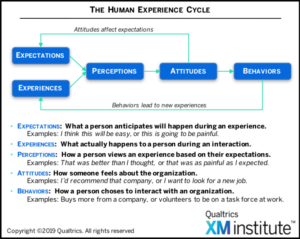Employee experience isn’t a trend or a fad or a buzzword. It is, and will continue to be, a shift in how we do the work of unlocking human potential at work. If you haven’t already embraced this shift, now is the time. The best place to start is to get educated about experience, what it means, and why it matters.
Today’s post is about pointing you towards one great resource for doing just that.
Over the past several years serving as an advisor to the North American Employee Engagement Awards, I’ve had the opportunity to get to know Aimee Lucas and her work at the Temkin Group (now the Qualtrics XM Institute). Each year, she presents some great insights and research findings at the event showing the strong linkages between employee engagement and customer satisfaction.
Aimee and her group have been at the forefront of the conversation about both customer and employee experience. At this year’s event, she shared a model they call “The Human Experience Cycle” that is a helpful way of understanding how experience works. The thing I love most about this model is that it clearly outlines the role that individual expectations play in how we experience things.
You can read more about the model here. It applies to both customer and employee experience. And it helps explain how to shape and measure experience.
Beyond this model, the Qualtrics XM Institute website is a treasure trove of resources available for free. At the site, you’ll find research and guidance about both employee and customer experience and, more critically, the relationship between them. Below are a few I recommend that you check out as you continue your education in this emerging domain.
Insight Report: Employee Engagement Competency & Maturity, 2018 – Download
- “When we compared companies with above average employee engagement maturity to those with lower maturity, we found that employee engagement leaders have better customer experience, enjoy better financial results, have more coordinated employee engagement efforts, have more widespread support across employee groups, are more likely to act on employee feedback, and face fewer obstacles than their counterparts with less engaged workforces.”
- “The top obstacle to employee engagement activities continues to be the lack of an employee engagement strategy.”
Insight Report: Propelling Experience Design Across an Organization – Download
- This is a great resource to understand the work of designing experience. It’s focused on customer experience, but if you replace the word “customer” with “employee” as you read, you’ll begin to see the impact.
- “This report explores how companies can use Experience Design – which we define as a repeatable, human-centric approach for creating emotionally resonant interactions – to craft consistently excellent interactions and how they can share and spread these capabilities across the entire organization.”
Post: The Inextricable Link Between CX & EX
- “Although the connection between customer experience (CX) and employee experience (EX) may seem obvious to many people, it’s important that we periodically test the linkage. So we took a look at the data from our survey that drove the report, State of CX Management, 2018.”
Post: The Engaging Power Of Employee Feedback
- “In our Q3 2018 Consumer Benchmark Study, we found that 40% of full time U.S. employees strongly agrees with the statement, ‘My company asks for my feedback and acts upon what I say.'”
- “Eighty-two percent of employees who strongly agree that their company takes action on their feedback are likely to do something good for the company, compared with only 30% of those who do not agree.”


